What is Critical Race Theory?

Over the past several months, state and local policymakers have been debating the contents of public-school curricula, and Critical Race Theory (CRT) has taken center stage. 26 states have recently proposed legislation that would ban school districts from teaching CRT.
Supporters of these bans, such as Republican Senator Ted Cruz, say that the theory “teach[es] our kids that all white people are racist and there’s nothing you can do about it.”
Meanwhile, when questioned about CRT being taught in elementary and secondary schools, White House Press Secretary Jen Psaki said that “kids should learn about our history…not just the good, but also the challenging.”
According to a Reuters/Ipsos poll, only 57% of Americans say they are familiar with CRT, and of those, a third believe that the theory “says that white people are inherently bad or evil.”
And while much of the debate about CRT in schools is happening on the school district level, the National Association of Educators supported the instruction of CRT, recently asserting “it is reasonable and appropriate for curriculum to be informed by academic frameworks for understanding and interpreting the impact of the past on current society, including critical race theory.”
But what is CRT really? And what kind of changes—to America’s laws, culture and customs—do CRT adherents envision? The New Center decided to dig into the work of the scholars who developed CRT as well as its most prominent contemporary advocates, and to explain, in their own words, the implications that follow:
Scholar | Explanation/Definition | Implications |
- “The critical race theory movement is a collection of activists and scholars interested in studying and transforming the relationship among race, racism, and power…Unlike traditional civil rights, which embraces incrementalism and step-by-step progress, critical race theory questions the very foundations of the liberal order, including equality theory, legal reasoning, Enlightenment rationalism, and neutral principles of constitutional law.” | - “erase barriers to upward mobility for minority populations.” | |
- “It is a way of looking at law’s role platforming, facilitating, producing, and even insulating racial inequality in our country, ranging from health to wealth to segregation to policing.” |
| |
- “Critical race theorists were the first to recognize that—despite conservative Americans framing certain laws…as ‘race neutral’ because they did not have any racial language in them—these laws had a racial impact, an impact that led to the reinforcement of racist structures in this country. Critical race theorists are keying on examining the way the law reinforces structures of racism and white supremacy.” | - “the only remedy to past discrimination is present discrimination. The only remedy to present discrimination is future discrimination.” | |
- We must accept “the reality that we live in a society in which racism has been internalized and institutionalized,” | - “Black people will never gain full equality in this country. Even those herculean efforts we hail as successful will produce no more than temporary ‘peaks of progress,’ short-lived victories that slide into irrelevance as racial patterns adapt in ways that maintain white dominance.” | |
-“Americans share a common historical and cultural heritage in which racism has played and still plays a dominant role… a large part of the behavior that produces racial discrimination is influenced by unconscious racial motivation.” | - [America’s judiciary needs] “a new test to trigger judicial recognition of race-based behavior… This test would thus evaluate governmental conduct to determine whether it conveys a symbolic message to which the culture attaches racial significance. A finding that the culture thinks of an allegedly discriminatory governmental action in racial terms would also constitute a finding regarding the beliefs and motivations of the governmental actors: The actors themselves are part of the culture and presumably could not have acted without being influenced by racial considerations, even if they are unaware of their racist beliefs. Therefore, the court would apply strict scrutiny.” |
